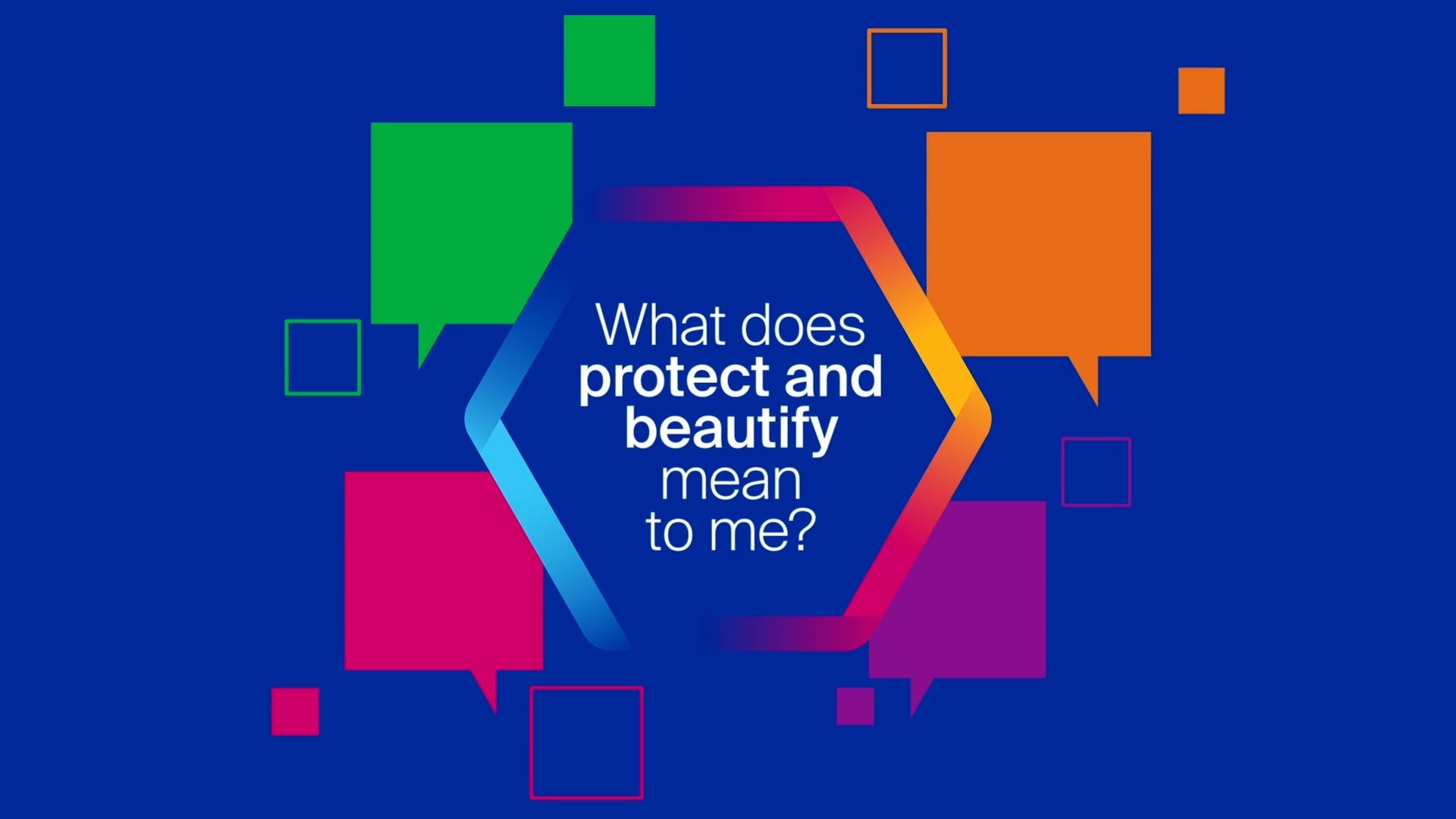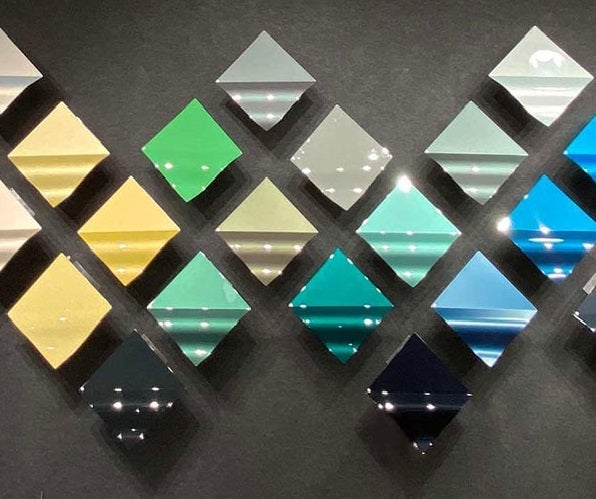Our vision is to be the first-choice partner to meet our customers' evolving needs for innovative paints, coatings and specialty materials.
We protect and beautify the world®

Operations in 70+ countries

$15.8 billion in sales in 2024

44% of sales from sustainably advantaged products in 2023

Our Purpose
PPG is a global team of innovators, achievers and partners united by the single belief that our paints, coatings and specialty materials enrich lives. Together, we protect and beautify the world.

Innovation
We're a global team of innovators, achievers, and partners driven to find solutions that meet our customers' greatest needs.
We've committed to having 50% of our sales come from sustainably advantaged products by 2030.
We innovate sustainably, developing products and services that enable our customers to increase productivity and be more sustainable.
We annually invest ~3% of our net sales toward research and development.

Color
We bring customers' visions to life through color, delivering paints via innovative processes that ensure they perform at their best no matter what climate or conditions they're exposed to.
PPG 2025 Color of the Year
Purple Basil
Purple Basil is a sophisticated, elegant color that works well in both traditional designs and edgier applications. As a purple, it’s warm enough to be inviting but cool enough to create an air of mystery.


Sustainability
We succeed by helping our customers succeed, partnering with them to create industry-leading sustainable innovations that help improve productivity.
We're on a mission to bring color and brightness to the communities where we live and operate.

$18.4 MM

~600

400+
We’re investing $5MM by 2030 to environmental sustainability education, aligned with climate action and a more circular economy.
In 2024, PPG and PPG Foundation invested $18.4+ million to support more than 400 local community partners and programs in the U.S. and internationally focused on advancing education and delivering community sustainability while encouraging the volunteer power of our employees.
In 2025, PPG’s COLORFUL COMMUNITIES® program celebrates 10 years of beautifying and revitalizing communities around the world.
For us, "protecting and beautifying the world" has always gone hand in hand with our commitment to sustainable innovation, advancing our industry for the better with each passing year.
Celebrating more than 140 years of innovation and color leadership
PPG was founded in 1883 when Capt. John B. Ford and John Pitcairn started the first commercially successful plate glass factory in the United States, in Creighton, Pa. Known as the Pittsburgh Plate Glass Co., the enterprise focused on innovation and quality. More than 140 years later, PPG remains dedicated to these priorities.
1900s
- During the company’s first decade, its flat glass production expanded rapidly through new facilities and acquisitions. In 1899, the business diversified with the construction of an alkali plant in Barberton, Ohio, to supply raw materials for glassmaking – the precursor to PPG’s chemicals businesses. A year later, PPG started building its coatings business by acquiring an interest in Wisconsin-based Patton Paint Co. which proved a good fit for the company because paint and glass products typically reach the customers through the same distribution channels.
- During the 1900s, PPG becomes one of the first U.S. firms to expand operations in Europe, acquiring a glass plant in Belgium.Glass and paint provided continued growth in the 1920s, as the automotive industry and skyscraper construction expanded.
1920s
- The automotive industry starts using more glass as the open touring car gives way to the sedan.
- PPG revolutionizes plate glassmaking with straight line conveyor-based ribbon method – a vast improvement over the batch method.
- PPG begins supplying aerospace transparencies, providing roll-up windows for the Ford Trimotor.
- PPG acquires Ditzler Color Company and begins producing more than 500 "harmonious hues" for 40 automakers.
1930s
- PPG introduces SOLEX® heat-absorbing glass.
- PPG shows its muscle and introduces Herculite tempered glass, several times stronger and more shatter-resistant than ordinary plate glass.
1940s
- The year before Pearl Harbor is attacked, PPG develops laminated aircraft glass. During WWII, the company converts much of its production into materials for military use and begins to develop synthetic resins that lead to plastics, high-performance paints and industrial coatings.
- In the early 1940s, PPG entered the optical products business with the introduction of CR-39® optical monomer. The company has a vision for its future as it patents CR-39 monomer and begins a journey into creating a successful line of optical products (which will later include Transitions lenses). This material still is used widely in prescription lenses, along with the company’s array of other lens materials.
1950s
- Post-WWII prosperity leads to increased car production and home and building construction. The company introduces lead-free house paints and begins to manufacture fiber glass for circuit boards, window screening and plastics reinforcement.
- In 1952, PPG established its fiber glass business, recognizing the potential of another type of glass product.
1960s
- Cars get a new lease on life as PPG revolutionizes the auto industry with the commercialization of the electrodeposition coating process, virtually eliminating rust.
- PPG's businesses are diverse. A number of foreign production operations and strategic planning moves the company toward a global focus. At the same time, the historic plate process for making flat glass is becoming obsolete with the adoption of the much more efficient float process.
- Reflecting its diversification, Pittsburgh Plate Glass Company changes its name to PPG Industries. As a bonus, the company reaches $1 billion in sales. A result of its diversification, growth and increasingly global presence, the company changed its name to PPG Industries in 1968.
1970s
- The oil embargo and rising costs of gas and electricity revive interests in solar energy. PPG is the first major corporation to develop a flat-plate solar collector.
- PPG expands its groovy color palette by introducing the DesignaColor System for custom-tinting consumer paints.
1980s
- PPG introduces TESLIN® substrate, a synthetic printing material that resists water, abrasion, extreme temperatures and UV damage. Its durability makes it ideal for passports, photo IDs, maps, menus and much more.
- In 1987, PPG's chlor-alkali business makes a splash when it introduces the SUSTAIN® Pool Care System, delivering chlorine more evenly and accurately for easier pool care.
- In 1989, PPG begins a flurry of acquisitions that expand the company's offering of automotive, industrial, aerospace and packaging coatings around the world.
1990s
- PPG develops photochromic lenses that automatically darken in sunlight and block harmful UV rays. Today, TRANSITIONS® lenses are the eyecare industry's most recommended photochromic lenses.
- Becoming ever-more global, PPG opens a new development laboratory in Japan for automotive coatings.
- In 1998, PPG proves its "can-do" attitude by developing more efficient solvent-based coatings for easy-opening lids on beverage cans.
2000s
- As the need for alternative energy sources grows, PPG fiber glass plays a role in the manufacture of lighter and stronger wind turbines.
- PPG broadens its transparent armor product portfolio with the acquisition of Sierracin Corp., adding high-performance lightweight transparent armor solutions that can withstand severe ballistic and blast threats.
- In 2008, PPG makes the largest acquisition in its history, of the SigmaKalon Group, a worldwide coatings producer. SigmaKalon brought strong architectural paint, protective and marine coatings, and industrial coatings businesses, and it greatly expanded PPG’s footprint in Western and Eastern Europe, Asia, and Africa.
2010s
- PPG continues to accelerate the pace of its business portfolio transformation and to grow its position as the leading global coatings and specialty products company.
- In January 2013, the company successfully separated its chlor-alkali and derivatives business and then merged its wholly-owned subsidiary Eagle Spinco Inc., the entity holding the former chlor-alkali and derivatives business, with a subsidiary of Georgia Gulf Corporation. The combined company formed by this transaction is named Axiall Corporation.
- PPG also acquired the North American architectural coatings business of AkzoNobel in 2013 – the second largest acquisition in the company’s history at that time.” This acquisition has expanded PPG’s customer reach in the U.S., Canada and the Caribbean; it has also made PPG the largest coatings company worldwide. With 2011 revenues of about $1.5 billion, the acquired business includes leading brands such as GLIDDEN, FLOOD, LIQUID NAILS, SICO and CIL, and PPG will license the DULUX and DEVOE architectural coatings brands and the SIKKENS architectural wood products brand.
- In June 2014, PPG reached a definitive agreement to acquire Consorcio Comex, S.A. de C.V. (“Comex”), an architectural and industrial coatings company with headquarters in Mexico City, Mexico. The company has approximately 3,900 employees, eight manufacturing facilities and six distribution centers, and had sales of approximately $1 billion in 2013.
2020s
- PPG completed the acquisition of Tikkurila, a leading Nordic paint and coatings company. Tikkurila was established in 1862, and is headquartered in Vantaa, Finland.
- In November 2024, PPG completed the sale of its silicas products business for approximately $310 million in pre-tax proceeds to QEMETICA a Warsaw, Poland-based, privately held manufacturer of soda ash, silicates and other specialty chemicals.
- In December 2024, PPG completed the sale of 100% of its architectural coatings business in the U.S. and Canada at a transaction value of $550 million to American Industrial Partners (AIP), an industrials investor.
Today
- More than 140 years after its founding, PPG still holds true to the spirit of Ford and Pitcairn: We Protect and Beautify the World, offering customers in a wide range of markets and geographic locations unique technologies, services and other solutions.
